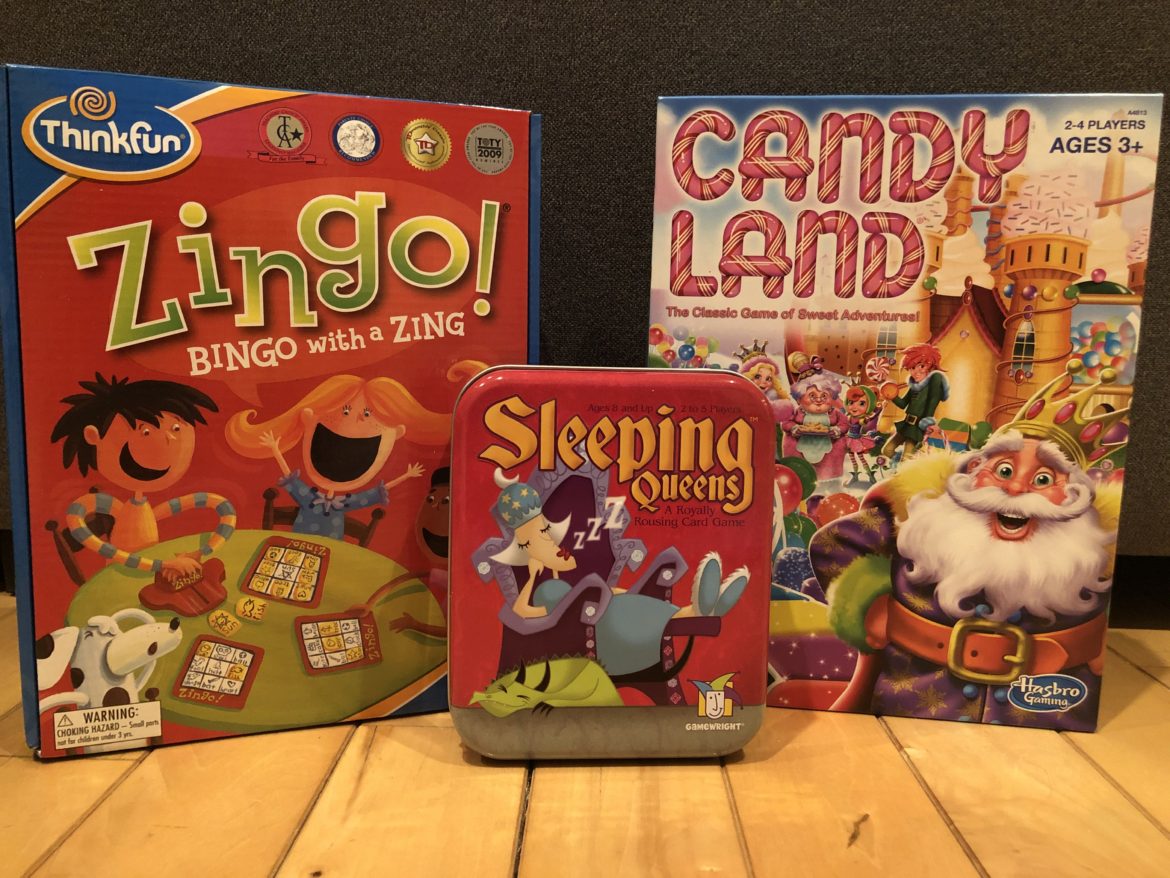After the post about board games children play in Germany, here are some games that are staples in many U.S. households. Board games are fun ways to interact with children and practice their English. For each game, I included some keywords to indicate what language skills certain game promote.
Candyland (Ages 3+)
Number of players: 2-4 Players
A definite staple in almost any child’s life in the United States: Candyland! The popular racing game takes 15-20 min to play. The board consists of a winding, linear track made of red, green, blue, orange, yellow, and purple spaces. Additionally, the game has cards with either one or two color square on them. Players take turns removing the top card from a stack. Then, the players need to move their marker ahead to the next space of that color. Some cards have two marks of a color, in which case the player moves the marker ahead to the second-next space of that color. The goal: you have to get to King Kandy’s castle first to win.
Skills: colors, counting
Chutes and Ladders (Ages 3+)
Number of players: 2-4
Spin the spinner and move your figure exactly the number of spaces forward on the path. If your figure stops its move on the bottom of a latter square, then you can move up the latter, thus getting closer to the finish line by skipping a number of squares. If your figure stops on top of a chute space, you slide down and basically go back. The first player to reach the winner square (number 100) on the board wins.
Skills: numbers, counting
Zingo! (Ages 3+)
Number of players: 2-7 players
The game is just like Bingo, but with a zinger! The game includes:
- 78 double-sided tiles with images and the words underneath.
- 7 two-sided boards (green side: easier; red side: more challenging)
- A zinger that distributes the tiles
Each player gets at least one board. The players then take turn sliding the zinger to reveal two tiles with a word/image on it. When a player sees a tile with an image on it that is also on her board, they need to call out the name of the image. The first player to call out the image correctly gets the tile and can place it on the printed image on her board. If a tile is not claimed, it goes back into the zinger. The player to cover all words/images on her board wins.
Skills: image & word recognition, vocabulary, letter-sound relationship, concentration
Sleeping queens (Ages 4+)
Number of players: 2-5 players
Sleeping queens is a card game that was invented by a 6-yer old girl named Miranda Everts. The card deck includes 85 cards (16 queens, 10 kings, 4 jesters, 4 knights, 4 sleeping potions, 3 wands, 3 dragons and 4 cards of each number 1-10). Each card as a point value. At the beginning of the game, the queens are put face down (asleep) on the table. The remaining cards are shuffled and each player gets five cards. The rest of the cards are placed face down in a draw pile in the center of the table. Only Kings can awaken Queens. But you can steal a Queen from another player with a Knight or make another player’s Queen go back to sleep with a Sleeping potion. The goal of the game: to collect 5 Queens (there are other versions too).
Skills: vocabulary (esp. magic-related words); numbers
Guess who? (Age 6+)
Number of players: 2
Guess Who? is a two-player character guessing game. At the beginning of the game, each player has a board with images of 24 people and their first names. All images are standing up right. Then each player takes a card from a separate pile of cards that has the same 24 images. The goal of the game is to be the first to guess which character the opponent has picked. Players take turns asking ‘yes or no questions’ like “Does your person have red hair?”. The player will then exclude characters based on the opponent’s response by flipping those images down. That continues until only one character is left or a player has guessed the opponent’s character correctly.
Skills: yes-no questions
Operation (Ages 6+)
Number of players: 1+
The game requires players to cure the patient’s ‘funny ailments’ (e.g., broken heart; butterflies in the stomach) by performing operations. It takes some hand-eye-coordination because operations are performed with tweezers which you as the doctor need to use to remove the ailments. Thereby, the player has to make sure that she doesn’t touch the side of the patient. When that happens, the buzzer will go off, the patient’s nose will light up, and a specialist needs to be called to see if they can fix the problem. A player gets money for successful operations.
Skill: vocabulary (esp. about the human body)
Apples to Apples Junior (Ages 8+)
Number of players: 3+
This is the Apples to Apples version for children. The card game lets you make crazy comparisons. The official age is 9+ but younger children should be able to play with a bit of support from mom and dad. The game takes about 30-60 min to play. At the beginning each player receives five red cards with nouns on them (e.g., Underwear, Africa, A Funeral, Gymnastics, Vacuum cleaner). Players should not show them to the other players. Then the judge lays down one green card with an adjective on it (e.g., sporty). Looking at the red cards in your hands, you have to decide which object is the most sporty one. You put that red card face down on the table. The judge shuffles the cards so she doesn’t know who put down what card and then looks at all cards. Then she has to make a decision which card fits best (aka ‘which object is the most sporty’). Players can chime in and argue for or against certain objects, leading to a friendly discussion (e.g., why is Underwear the best choice). The person whose card is picked by the judge gets a point. The first player to have five points wins.
Skills: vocabulary, comparisons, creative thinking skills, argumentation
Scrabble (Ages 8+)
Number of players: 2-4
Each player draws 7 tiles from a pool of 100 tiles. Each tile is worth a different number of points. The players score points as they take turns, forming words—similar to a crossword puzzle—on a square game board. The board has special squares that double or triple the points a player receives if she places a tile on it. The person with the most points at the end wins.
There is also a Scrabble Junior that focuses on letter matching.
Skills: vocabulary, spelling
The Game of Life (Ages 9+)
Number of players: 2-6
The Game of Life (or just Life) is a board game that was created in 1860 by Milton Bradley. It parallels steps and choices we take in real life.
Each player begins with $10,000 (well…maybe not exactly parallel to real life). At the beginning of the game, each player has to decide if they want to go to college or start their career early. If a player decide to go down the career path, they pick a career card and a salary card. For instance, you pick the career card “artist” and then a salary card (e.g. $30,000). The game board has a spinner with numbers from 1-10. Your figure moves the number that shows on the wheel. If you chose career over college, and you spun a 5, you get to move 5 spaces on the career path. If thereby you passed a payday field, you can collect $30k from the bank (your artist salary). The field you land on has an additional description such as “You won a marathon for $10k.” or “You have to pay $5k for rent”. As you move forward, each player collects money and life tiles as they make their ways through potential life events such as getting married, buying a house, having a child, going to night school, encountering midlife crisis, making career choices, getting loans etc. At the end of the line (retirement), the player with the most money and life tiles wins.
Skills: practicing numbers, reading comprehension

